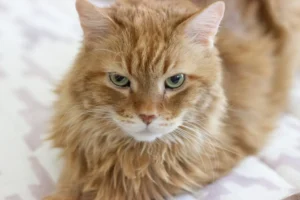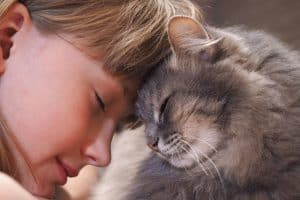Cats are known for their sassy and independent attitudes, but have you ever wondered why they possess so much attitude in the first place? Let’s take a closer look at the reasons behind our feline friends’ feisty behavior.
Have you ever noticed how cats seem to have a mind of their own? From the way they strut around like they own the place to their reluctance to follow commands, it’s clear that cats have a certain level of attitude that sets them apart from other pets.
Feline Independence: A Natural Instinct
Cats are known for their strong independent nature, which significantly influences their attitude and behavior. Unlike dogs, who often seek constant companionship and approval from their owners, cats are more aloof and prefer to do things on their terms. This independence stems from their instinct to survive on their own in the wild.
You may have noticed that your cat doesn’t always come running when you call its name or may wander off to explore on its own. This is because cats are wired to be self-sufficient hunters, relying on their own skills to find food and shelter. Their independence leads them to have an attitude of self-assurance, often appearing aloof or uninterested in human interaction.
Next time you catch your cat ignoring you or doing its own thing, remember that this behavior is rooted in their innate instinct for independence. Embrace their independent spirit, and you may just find yourself admiring their confidence and self-reliance.
Territorial Tendencies: Defending Their Domain
Cats are fiercely protective of their territory, whether it’s your home or the neighborhood they roam. This territorial behavior is ingrained in their instinct to mark their territory and defend it from intruders, whether that’s another cat or a curious squirrel.
When a cat rubs its face against furniture or scratches a tree outside, it’s not just a cute gesture – it’s a way for them to leave their scent and mark their territory. This territorial marking helps cats establish boundaries and communicate with other animals in the area.
If you’ve ever seen your cat hiss or puff up when a stray cat wanders into your yard, it’s because they are fiercely defending their domain. Cats take pride in their territory and will do whatever it takes to protect it, even if it means displaying a bit of attitude.
Remember, when your cat acts territorial, it’s not personal – it’s just their natural instinct at play. By understanding and respecting their need to defend their space, you can build a stronger bond with your feline friend based on mutual respect for their territorial tendencies.
Playful Prowess: A Source of Entertainment
Have you ever wondered why cats seem to have so much attitude? One key reason lies in their playful prowess. Cats are natural hunters, and their high energy levels drive them to engage in playful behaviors like pouncing, chasing, and swatting. This playfulness can sometimes be misinterpreted as attitude when, in reality, it’s their way of staying entertained and honing their hunting skills. So, next time your cat zooms around the house or bats at a toy with an intense focus, remember, it’s all in the name of fun!
Communication Cat-titude: Understanding Their Signals
Understanding a cat’s communication style is crucial in deciphering their so-called “attitude.” Cats use a combination of vocalizations, body language, and scent cues to express themselves to their humans. For example, a flicking tail might indicate irritation, while purring can signal contentment. Misinterpreting these signals as attitude can lead to misunderstandings between you and your feline friend. By learning to read your cat’s cues accurately, you’ll be better equipped to respond appropriately and strengthen your bond. Next time your cat “acts out,” take a moment to assess their body language and vocalizations to determine what they’re trying to tell you.
Key Insight: Cats may exhibit attitude-like behavior when they feel stressed or anxious. Understanding their body language cues can help identify when they need extra comfort or reassurance.
Additional tips for decoding your cat’s behavior:
- Ears: Forward and relaxed ears indicate a friendly mood, while flattened ears suggest fear or aggression.
- Eyes: Dilated pupils may signify excitement or fear, while slow blinking is a sign of trust and affection.
- Vocalizations: Different meows, purrs, and chirps can convey a range of emotions, from hunger to happiness to frustration.
- Posture: A relaxed and open posture indicates comfort, while a tense body with arched back signals potential aggression or fear.
- Tail: A high, upright tail signifies confidence, while a puffed tail indicates fear or agitation.
By paying attention to these subtle cues, you can better understand your cat’s behavior and respond in ways that nurture a positive relationship.
Selective Affection: Expressing Love on Their Terms
Cats are known for being independent creatures, and this independent nature extends to how they show affection. While dogs may shower their owners with slobbery kisses, cats have a more subtle approach to expressing love. They may choose to curl up in your lap, rub against your legs, or even give you a gentle headbutt. These gestures may seem standoffish to some, but it’s all part of a cat’s unique way of showing love. Remember, cats are selective in their affection, and when they choose to show it, it’s truly special.
Mood Swings: The Emotional Side of Cats
Just like humans, cats experience a range of emotions that can influence their behavior and attitude. From playful and affectionate one moment to aloof and moody the next, cats can go through a whole rollercoaster of emotions. Factors like changes in their environment, health issues, or even boredom can all play a role in shaping a cat’s mood. Understanding and acknowledging these moods can help you better connect with your feline friend.
- Stress: Cats can easily get stressed by changes in their environment, such as moving to a new home or the introduction of a new pet. Providing a safe and familiar space for your cat can help alleviate stress and improve their overall mood.
- Enrichment: Keeping your cat mentally stimulated with toys, scratching posts, and interactive play can help prevent boredom and reduce negative emotions.
- Routine: Cats thrive on routine, so maintaining a consistent feeding schedule, playtime, and sleep routine can help keep their mood stable and content.
For more insights on understanding your cat’s emotions, you can check out this comprehensive guide on feline behavior: Understanding Your Cat’s Emotions.
When dealing with a cat’s attitude during training, patience is key. It’s essential to understand that cats are independent creatures with their own unique personalities, so pushing too hard can backfire. Instead, try using positive reinforcement techniques like treats and toys to encourage good behavior. Consistency is also vital – establish clear boundaries and stick to them.
Remember, cats respond best to calm and gentle guidance. Yelling or punishment can cause more attitude issues, so always opt for a soft approach. If your cat is being particularly stubborn, take a break and try again later. Don’t give up; persistence pays off in the long run.
One surprising tactic that can work wonders is harnessing your cat’s natural instincts. For example, using toys that mimic hunting behaviors can channel their energy in a positive way. By tapping into their natural behaviors, you can often find common ground and make training more effective.
Bonus Tip: Consider consulting with a professional animal behaviorist for personalized advice and guidance tailored to your cat’s specific needs. Their expertise can offer valuable insights and strategies to help you navigate any behavior challenges with your feline companion.
Fun Feline Facts: Surprising Insights
Did you know that a cat’s attitude is closely linked to their ancestors’ wild instincts? Despite being domesticated, cats still retain many of the traits that helped them survive in the wild. This includes their independent nature and strong sense of territory, which can manifest as attitude in certain situations.
Cats also have a unique way of communicating through body language. From tail flicks to ear movements, their posture can reveal a lot about their mood and intentions. Understanding these subtle cues can help decipher your cat’s attitude and respond accordingly.
Surprisingly, a cat’s purr isn’t always a sign of contentment. While it’s commonly associated with happiness, cats may also purr when they are anxious or in pain. It’s their way of self-soothing in stressful situations, so don’t always assume a purring cat is a happy cat.
One fascinating fact is that cats have a specialized scent gland on their face called the “glands of Nansen.” These glands release pheromones that help them mark their territory and communicate with other cats. By rubbing their face against objects or people, they are instinctively claiming ownership and sharing information with their surroundings.
So, next time your cat displays attitude, remember that it’s all part of their complex nature rooted in centuries of evolution. Understanding and respecting their instincts can help foster a stronger bond and navigate any challenges with grace.
Alex, a passionate animal lover, has experience in training and understanding animal behavior. As a proud pet parent to two dogs and three cats, he founded AnimalReport.net to share insights from animal experts and expand his knowledge of the animal kingdom.









